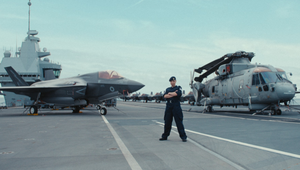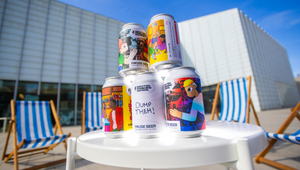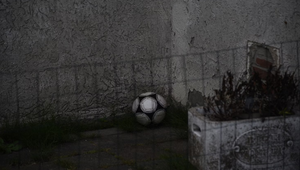
How Greene King Linked Past and Present through Stop Motion

Greene King has collaborated with House337 to launch a campaign for their first ever craft beers, ‘Level Head’ and ‘Flint Eye’. Directed by BlinkInk’s Balázs Simon, the film concentrates on Britain’s eccentric past, but also speaks to a new generation of craft beer lovers in a very special way.
Bridging the company’s 200 years of heritage with their first endeavour into the world of craft beers, Balázs’ project uses light and shadow play to create a 360 degree projection through 355 individually laser cut beer cans. The cans were then animated through stop frame animation to bring the story to life, while a light was placed inside each can to project the cut-out illustrations.
This technically challenging project played with the laws of the universe, as it entirely relied on the light. In order to create sharp shadows, the light had to be placed at the perfect distance away from the wall it was being reflected on. This meant calculating the anamorphosis of hand-drawn illustrations, meticulously programming motion controls, and building custom rotating light rigs in a blacked-out studio. Even though the process allowed for mistakes - which had to be carefully controlled and avoided - it also uncovered an unexpected ghostly quality in the way light reacted, elevating the final film.
LBB’s Zoe Antonov spoke to Balázs about the meaning and making of the campaign.
LBB> What was the brief for the campaign and what were the initial conversations surrounding it?
Balázs> Greene King has a huge heritage - they’ve been brewing beer for centuries. Their new line is their first foray into the craft beer market, so we wanted to emphasise how the brand’s history culminates in something for the present era (in a crafty way of course!).
At the beginning, we talked a lot about using a woodcut style and actually cutting the animation into wood veneer. That itself would’ve been very interesting to do, but I felt we needed a stronger connection with the product, and I wanted to give prominence to its modernity. We kept the heart of the idea, but instead of using wood, we created a 360 degree projector from the beer can, with legends bursting out of it.
LBB> The craft in the film is incredible! Why did you decide to go for stop motion and what message were you hoping to send with it?
Balázs> It was a very logical decision; we wanted to combine traditional hand craft with modern technologies to reflect on the brewery’s heritage and expertise. It was the perfect way to reenact some ancient legends (the brewery is located at Bury St Edmunds, hence the historic references in their branding), while creating something that feels contemporary and fresh. By making it frame by frame for real, I wanted to recognise Greene King’s centuries-long dedication to brewing.
Greene_King_BTS_EDIT_V10_No_Logos from Blink on Vimeo.
LBB> Do you believe stop motion is starting to become a main pillar of storytelling in advertising?
Balázs> You could ask a similar question with ‘Will AI take away creative jobs?’.
From a certain point of view, the answer to that is yes. It’s already starting to feel like you can swap spending a decade honing your craft with a piece of software that does something similar in an instant. Soon, algorithms will be able to mimic not just art styles, but also thought processes that lead you to the result. Will AI become the main pillar of storytelling then?
Maybe I’m too optimistic, but I don’t think that will be the case. In my opinion, people will always be interested in other people, and that’s the biggest driving force behind all forms of communication. We’ll always want to see what other people think or feel, and experience reality, no matter the digital achievements we’re surrounded by.
Human experience has progressed into a state where it sits simultaneously in an ‘analog’ and ‘digital’ world, and that affects the stories we’d like to share. Modern stop motion is an exciting middle ground where these worlds can seamlessly coexist. The idea of this duality is already a main pillar. Just think of the desire to inject a human feel into CGI productions (like the stop-motionness of ‘Cash In Cash Out’ for Pharrel Williams), or adding a digital feel to live action shoots (like the linear motion control camera moves in ‘HUMBLE.’ for Kendrick Lamar, or the airy, weightless feel of Burberry’s ‘Open Spaces’).
LBB> Tell us more about the animation process that went into the film!
Balázs> Even though the idea boils down to something very simple (light in a can), getting there was an elaborate process! At the end of the day, everything we did had to be very mathematical, in order for it to work. So, we created an accurate 3D previs with close to final camera work and environment, and the 2D animators drew the animation directly on this. This way, we could present the idea to the client very early, and we also enabled the animators to more easily focus on their craft. They didn’t have to worry about the technology, they only had to draw things where they wanted the light to hit the walls.
Once the 2D animation was done, we projected them on the can surface. The algorithm took into account the viewing angle, the shape of the environment, and even the occasional wobbling of the can. This anamorphosis then got laser cut into metal sheets, which were hand rolled into 355 individual cylinders.
We rebuilt the set based on the 3D designs, and once everything was done, we went to the studio. We had to place the motion control rig in a way that the real camera sensor exactly matched the virtual one we used for the calculations. This had to be millimetre perfect and took days to fine tune - with several rounds of back and forth between the animation software and the camera, often taking virtual measurements and transferring them to the real setup.
The creation of the light setup was so complicated that it is its own story. To get sharp enough shadows on the walls, we needed a light source that was as small as possible. But the smaller you go, the less light it will emit. We had to go with three to four second long exposures to expose the scene properly, so we had to black out the whole studio space. The animators worked in almost complete darkness, and because of the limited spread of the LED, they didn’t even see the whole projected image on the walls, only a smaller fraction of it. For every frame, they had to pick the can apart, replace the metal sleeve, and position the new one with a very fine accuracy.
It also took 120 animated DMX channels to get the right colour transitions in the environment, turning even the DP into an animator!
LBB> What were the illustrations inspired by and what story did you aim to tell with them?
Balázs> The illustrations were inspired by woodcut engravings from the mediaeval era, and the anamorphosis art of Hungarian artist István Orosz. We wanted to keep the offbeat fun of the old engraving styles, while also making sure it was still possible to laser cut them into aluminium. So, the style is also a combination of old and new: hand-drawn, but mapped onto metal sheets by bespoke ray tracing algorithms. They show the brewery’s connection to ancient English legends, like King Edmund’s beheading.
LBB> Who was your target audience for the campaign and how did you make sure to reach them?
Balázs> We wanted to target a younger generation, while acknowledging the history of the brand, and recognising its established fans. I wanted to create a feeling that there’s a lot of excitement to unpack here, with imagery they likely haven’t seen before. Instead of focusing on ordinary scenes you’d associate with beer, we went with a more sensory approach.
LBB> What was the most difficult part of the execution of the film? And what was the most fun?
Balázs> A generally difficult thing was to do it all without seeing what we were working on! Because the whole story is made from light, everything could fall into place only when we put it together on set and switched the LED on. That minuscule light was the focal point of the whole production, and it was the most difficult part to create.
Max (the DP) got an insane amount of LEDs to try out. Once he found a super strong one with great spread, he stripped its lens away and replaced it with an adhesive foil, in which we burnt a less than 0.2 millimetre hole with a laser. Andy (the rigger) engineered a custom socket for this LED, and we put it on a small motor with a slip ring, creating something like a lighthouse. Rotating the light exactly on the axis kept its small diameter, but extended its spread to 360 degree when taking a long exposure. On top of that, it had to sit in space with sub-millimetre precision to project the story without unwanted distortions.
Even though this was the most difficult (and crucial) thing to get right, it was also the most fun, seeing all of our efforts making sense and actually working!
LBB> Any final thoughts?
Balázs> Whenever I talk to people about this project, there’s a question that always comes up. Why didn’t we just resort to CGI?
It’s a good one. In a sense, we could’ve achieved,visually, a very similar film. But, I think it wouldn’t have told the same story.
I’m in love with reality, and the thing I hate about animation is that it’s so hard to ‘stumble on things’. When you shoot live-action, many times you can afford to be inspired on set, and try out things you weren’t prepared for. You’re presented with chaos, and your task is to create structure. I try to approach animation the opposite way - I’m constantly trying to find chaos in structure.
When we planned the animation, we didn’t know what kind of secondary reflections we’d get from the inside of the can and the coloured gels. That unpredictability added so much value to the film though. These quirks of our weird machine made the imagery quite glitchy and ghostly as it tried to summon past legends. It became ephemeral, lingering between reality and something intangible. We would’ve never achieved the same with a CGI approach.















